Mongolia: Rural vs. Urban
January 18, 2009
Part of the beauty of Mongolia’s complex cultural, historical, and geographical landscapes is the intensity of the contrasts therein. Perhaps the starkest of these contrasts is the one that exists between Mongolia’s rural and urban populations. This wild discrepancy shows itself in nearly every aspect of the two halves–be it in air quality, visual aesthetics, or simply in peoples’ personal attitudes and ideals. Without taking a glimpse at these differences, it’s impossible to begin to understand the full scope of life in Mongolia.
By some estimates, around half of Mongolia’s population( over 1 million of about 2.9 million) lives in the capital city, Ulaanbaatar. The city is a sprawling and polluted jumble of modern construction, business headquarters, factories, restaurants, and hotels in the center, with crowded ger districts climbing on to the surrounding hills in every direction. Ulaanbaatar’s situation in a bowl of large mountains once made it an ideally defensible location, but a combination of modern technology and the burning of coal in factories and private residences (which continue to increase in number at an alarming rate each year) has covered the city with an impenetrable blanket of smog during winters for decades.
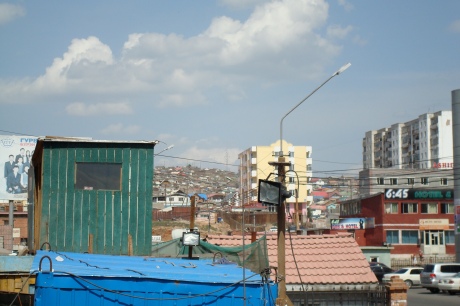
The ger districts can be seen in the distance
Ulaanbaatar is said to be the coldest national capital on Earth, with an average annual temperature of -1.3 °C (29.7 °F). During the winter, temperatures routinely drop to -40°C (-40°F), and survival in these conditions depends on the consumption of vast amounts of energy for heating. Apartment complexes and busineses are linked up to specialized or shared coal burning facilities, and each family in the ger districts burns wood and coal in individual stoves that double as cooking surfaces.
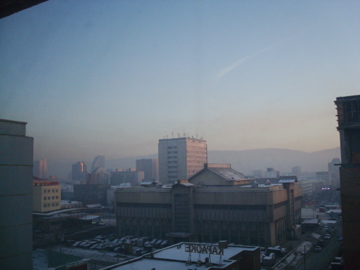
smog over Ulaanbaatar
On a personal note, stepping out of the bus from Arvaikheer in Ulaanbaatar (or UB, as it’s often called) is always a shock to the senses; the smoke in the air is so strong that I can sometimes taste it when I first breathe it in. This is normally one of the most irritating contrasts between the countryside and the capital during the winter, but Arvaikheer is certainly not without its own horrendously polluted days. There are times when the forecast calls for deeply cold weather in my town, and businesses, apartment complexes, and schools rev up their coal furnaces overnight accordingly. The next day, even if the weather turns out to be rather pleasant, the entire town has no choice but to wait for the coal fires to die down in the furnaces. In the mean time, buildings are super-heated, and the air around the town is pumped full of black smoke. Fortunately, Arvaikheer is only half-ringed by mountains, so smog can usually blow off into the desert with little impact on the immediate area. On days with no wind, though, it’s a different story…
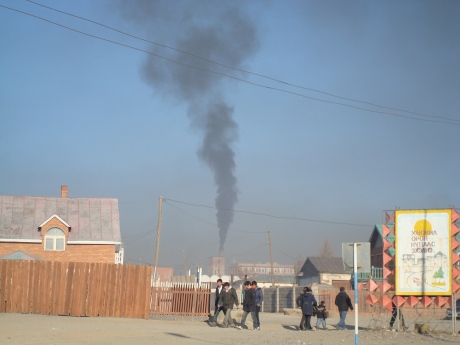
Arvaikheer on a smoggy day =/
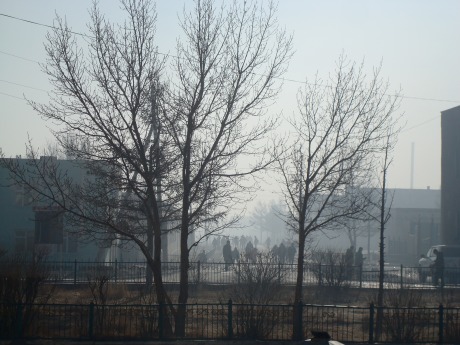
the same ultra-smoggy day in Arvaikheer =/
Thankfully, though, unlike UB in the winter, the sky in the countryside almost always looks like this (sans temple, maybe–and this photo actually shows an unusually large amount of ‘clouds’, but still) :
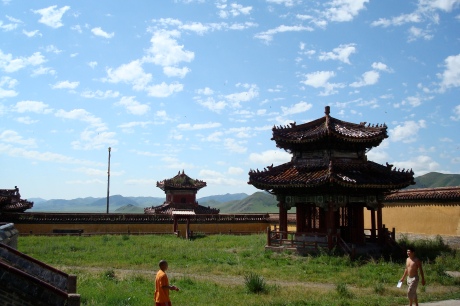
clean air at Amarbaysaglant Temple in Selenge, my former province of residence
Before going on any further, I should mention that the Mongolian word for ‘countryside’ is ‘hudoo’, and most Peace Corps volunteers consider the hudoo to be the sparsely populated or otherwise uninhabited parts of Mongolia. For instance, I would say that my summer home in Sant was located in the Hudoo, because my village only had 2080 people in it. To UB residents, however, every single place that is not Ulaanbaatar is the hudoo, whether it’s unpopulated expanses, small villages, towns, or even relatively well-populated cities. So, my current home in Arvaikheer is thought of by Uvurkhangai residents to be a city, while cab drivers in UB tell me I’m from ‘the hudoo’ whenever I tell them where I live.
I suppose I didn’t fully understand this discrepant labeling until I actually spent some time in Ulaanbaatar. As mentioned in previous entries, I had been living in a converted cardboard and plaster toolshed in a muddy (but beautiful) village all summer, and the closest thing to a city that I’d seen before August was Darkhan, population 70,000. So when I first got a chance to sit down in a classy UB mahogany-paneled Italian restaurant with roaming professional violinists and stained glass windows, I was amazed. And for those who are willing to pay the price, these places are available everywhere in Ulaanbaatar; sushi restaurants, night cubs, art galleries, natural history museums, paved roads, glass skyscrapers–physical and experiential evidence to support UB’s claim to being ” like little a European City.”
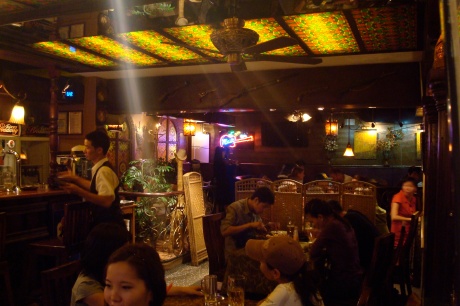
an alarmingly posh restaurant in UB
After a summer of village life, spending time in restaurants like the one pictured above was novel and refreshing. I only had about five hours of UB time before heading off to Arvaikheer at the end of the summer, though, so I never got the full experience until I returned to the city for a business meeting in October, and again in November and December. The times that followed were equally refeshing and rejuvenating, but each time I returned to Arvaikheer I was relieved to be out of the city. There’s something disruptive about suddenly exposing oneself to the comforts and amenities he or she left behind in a former lifestyle. Pizza and sushi remain at the top of the list of material things I miss most about my life in America, but transporting myself to a crowded Mongolian city where these things are at my fingertips involves a great deal of ancillary effort–the least of which is time commitment. The most difficult thing about allowing myself a taste of the lifestyle I left behind in America last May is the transition between rural and urban culture; the act of temporarily leaving the comforts I have worked hard to learn to appreciate in my simpler, rural lifestyle. I find that my trips to the city–to pizza, to sushi, to consumerism–also bring me closer to conflict, to excess, to noisy crowds. As I said before, I almost always return to Arvaikheer feeling relieved.
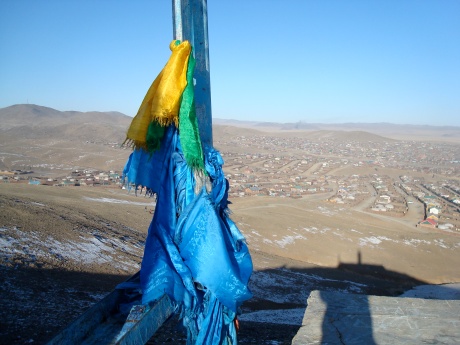
my town =)
As an American foreigner living in the Inner Asian remoteness of the former Soviet Union, my integration to the local and nationally prevailing cultural currents is bound to be strained. It hasn’t been an easy transition, but it’s also been a fascinating experience that has hinged on my ability to balance my existence along the same rural-vs-urban line that cleaves the Mongolian population. As a westerner, my personal culture aligns quite seamlessly in certain material ways with the lifestyle of the capital city, but as a volunteer I feel that I can connect on a much more personal level with rural communities. As is the case in nations all over the world, the booming and crowded capital city inevitably produces and houses citizens with certain specific ideals, goals, and interpersonal trends that differ greatly from those that arise from the circumstances of a rural lifestyle. Ulaanbaatar and its surrounding ‘hudoo’ mass–the second largest landlocked country in the world–are no exception.

awwwww, 'hudoo' Arvaikheer =)
I’ve noticed during my several trips to UB that I rarely had to use any Mongolian language to get by. When I tried, or merely did so out of ‘hudoo’ habit, my conversation partners–waiters, storeclerks, hostel workers–seemed to always answer me in English (or some semblance thereof). Even homeless people in UB have mastered their (often complex) pleas for support in six or seven European languages, in hopes that one of them would work on my foreign ears. This ability to speak other languages both stems from and continues to feed foreign investment in the country, and English, Russian, German, Japanese, and Turkish language instruction programs throughout the nation continue to inspire rural youth to move to the city for work. Once in UB, these people take on quite a different air about them–akin, perhaps, to the proverbial American small towner changing completely after moving to New York. Among the most obvious of these changes is that few Mongolians in the most trafficked districts in the capital wear traditional Mongolian clothes; to do so would be to stand out, and residents of UB tend to look down on countryside dwellers and their attire in favor of a more ‘western’ look.
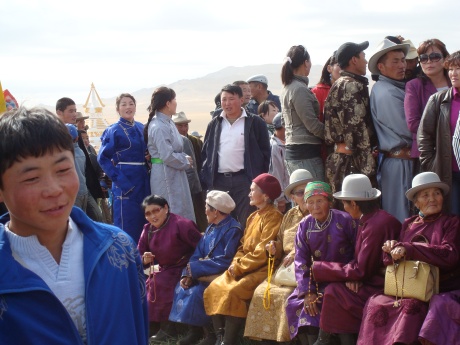
some women in traditional clothing at a local stupa complex opening ceremony outside of Arvaikheer
Concomitant with the personal agency changes that members of rural communites make upon living and working in UB is often the unfortunate departure from the collectivist interpersonal trends inherent to rural Mongolian lifestyles (if only due to separation from family members who remain in the hudoo). During my summer in Selenge Aimag, five of the six youths with whom I was closest in my village were in the process of receiving an urban college education, had already graduated from an urban university, or were planning to do so. These young people had different goals from those of their parents–most of whom were farmers. There is no telling what kind of effects this may have on the Mongolian agricultural economy in the future, but if Selenge was any indication of trends in youth goals, Mongolia will have some vocational restructuring to do in a few decades.
Alcoholism is an enormous problem in Mongolia, and it is incontrovertibly more pronounced in rural communities than it is in the cities. This stems from boredom and unemployment, mostly. With 50% of Mongolia’s population under the age of 25, it will be increasingly crucial to divert Mongolian youth away from alcohol in the coming years. To tie these most immediate thoughts together, then, it’s recently become one of my personal goals to engage in youth-directed alcohol awareness education with an emphasis on how to maximize the social and financial potential of living an educated rural lifestyle. I do not believe in steering all of Mongolia’s youth toward city life–especially not when they can be inspired to improve the quality of their own lives, as well as those of their communities, while simultaneously ensuring the security of Mongolia’s agricultural future.
Some of the rural-dwelling sheep herders in my province, incidentally, are among the wealthiest people in the region. If that’s not enough proof that Mongolians can circumvent the ‘City-or-Fail’ route, I don’t know what is.
*
If you have any questions about the contents of this post, feel free to leave them in the comments section. Thanks for tuning in!
Hey!!!!! This is the most fun and facinating thing I have ever read Patrick!!! I cant wait to share it with Barnesville and my friends! Your writing and depiction of life in Mongolia is awesome and inspiring! I cant wait to read it over and over until your next entry! I Love You!!!
Patrick, that is one of the most well-written and intriguing blog posts, nay, correspondence from abroad, I have ever read. Your writing is exquisite! If you aren’t already, consider asking a newspaper or news website here in the US about publishing posts like this one. I can’t wait to talk to you again! Later, Theron
Hey Patrick – I love your essays! It didn’t sound like complaining at all – just quirky travel reporting. Please keep writing your perceptive and engaging travelogue!
Susan
:^)
awesome
bi emeegiihee zuragiig olj haralaaa
Wow, what a great place to visit. Ulaanbaatar needs some green energy. I hope the government is looking into clean coal and nuclear energy. The people of Ulaanbaatar deserve a better quality of life and less pollution.
the most shocking thing is that mongolia has over 350 days of unadulterated sunlight a year, and a very underutilized solar energy usage. Wind energy could power the whole country, too, but there just isn’t a developed energy infrastructure on which to start these programs.
hey I have a question. I have to do a report on mongolia at my school. they requiree that I wear the modern clothing in mongolia. I dont know if its everyday clothes like in America, or something different. I really need to know or else I will fail this grade.
hey. i liked your blog. i just went on a two week trip to mongolia recently. i’d love to chat with you sometime.
🙂
this is a great post. I most especially love the “an alarmingly posh restaurant in UB” remark. I felt exactly the same thing when i went there. Broadway Pizza is the place, if im not mistaken.. I hope to hear more about your experiences in Mongolia!
Hi there,
I enjoyed reading this article, actually i wanna use some of your reflections on my research paper about Mongolian youth (I’m a PhD candidate at Sydney uni, Australia, doing research on the case of Mongolian youth). If you don’t mind, I would like to reference your full name in my paper, to avoid copyright and plagiarism. Would you mind giving me your full name and what you do in Mongolia, please?
Regards,
Sendi
Hi there,
I enjoyed reading this article, actually i wanna use some of your reflections on my research paper about Mongolian youth (I’m a PhD candidate at Sydney uni, Australia, doing research on the case of Mongolian youth). If you don’t mind, I would like to reference your full name in my paper, to avoid copyright and plagiarism. Would you mind giving me your full name and what you do in Mongolia, please?
Regards,
Sendi
Hey, that would be great. I’d be honored. My full name is Patrick Larsen Hamilton and I’m a TEFL (teaching english as a foreign language) volunteer at a primary/secondary school in Uvurkhangai Province. I just teach a lot of english and work on various community development projects (like library set up, community classes, etc). Good luck on your phd!)
Great post. I’ve only been out of Mongolia and I miss it a lot. The airag, the aruul, the nermel, the khurkhug…
Thanks for your informing and interesting post! My Montana has a very similar topography, climate, and industry as Mongolia. I’m curious about opportunities to have an extended working-visit to rural Mongolia. Any ideas?
Hello there! I’m a Mongolian girl who studies as an exchange student in Austria now.. I liked your post!
It’s really truths about Mongolia and especially the UB city..
But I hope that you liked to stay there! 🙂
Regards, Tsolmon
Hello,
Would i please be able to use some of your images in my report about mongolia? i would need to reference you in the report so can you please allow me to do so?
Regards
mel
sure thing!